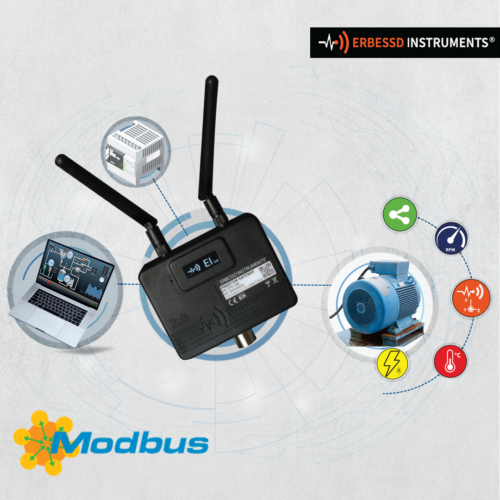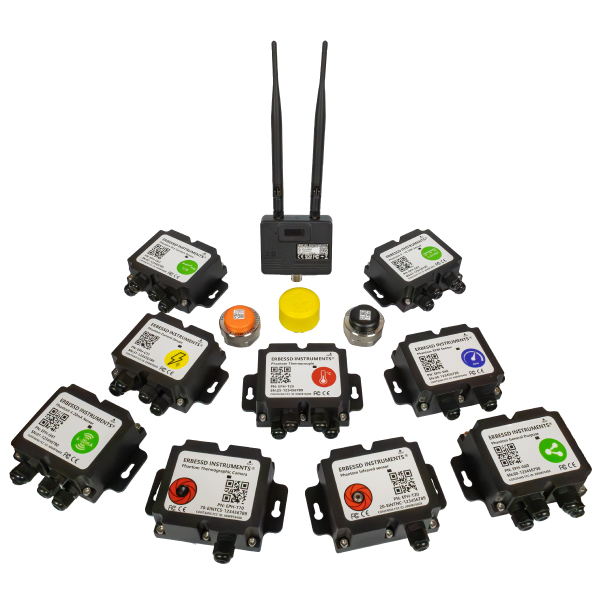
Wireless Modbus Sensors TCP/IP Erbessd Phantom® | Condition monitoring

Wireless Modbus Sensors & Condition Monitoring – The Best of 2 Worlds! Combining Phantom Wireless Sensors with an Industry Standard such as Modbus! The best in Vibration monitoring equipment!!
Erbessd Phantom Wireless Sensors now include Modbus TCP/IP, which is a widely known and used universal communication protocol for industrial applications, thus, making it compatible with any PLC, Scada system or any other Modbus TCP/IP communicating software.
What is Modbus TCP/IP?
When it comes to wireless vibration monitoring systems, Modbus is the most important Standard Protocol for Industrial Communication. Modbus is an open source protocol, and works under the Master/Slave model. It has been adopted as a standard communication protocol for sensors in the industry. Modbus TCP/IP is a particular variation of the original version (Serial and RTU) that communicates over a standard network, making Erbessd Phantom Wireless Sensors very easy to connect to one or many targets. Additionally, Modbus TCP/IP allows for multiple masters to read from the slaves, which opens a big window for many applications on the field. A great wireless vibration monitoring solution.
Security in wireless vibration monitoring.
The signal from the Erbessd Phantom sensors is encrypted, which ensures the reliability of the information and the security of your data that passes through this wireless monitoring system.
Erbessd Modbus Sensors Available – Wireless vibration sensors
A big variety of sensors are available for immediate installation such as:
- Temperature
- Vibration
- Current / Power
- Speed
- General purpose such as
- Pressure
- Liquid Level
- Phase Meter
- 4-20 mA sensors
Check out our Modbus Sensors Here >


Why Erbessd Wireless Modbus TCP/IP?
Modbus is a very easy to learn protocol, and also a widely accepted communication standard. Additionally, it is an open source protocol, which makes thousands of API’s to be available in the internet for every single programming language. Modbus is very easy to use and to integrate in any existing network.
On the other hand, Modbus over TCP/IP is very reliable, meaning it does not need to be set in network. Any master will know when a slave has been disconnected.
Applications for Wireless Modbus TCP/IP: Condition Monitoring System
You can use Phantom Wireless Sensors Modbus in many industrial applications. A few points to keep on mind:
- Scada systems for control automation
- PLC for machinery control and protection
- ERP software such as SAP
- Integration with self-designed applications with free APIs
- Connecting wireless sensors for super big distances (kilometers) using the cloud.


Erbessd Phantom Wireless Modbus Integration
To provide an array of condition monitoring solutions, Erbessd Wireless Sensors integrate Modbus communications in 2 important ways.
The first one comes directly from the hardware and requires no additional software.
The Second Modbus Integration comes with “EI-Monitor” Software module which allows sharing post-processed data, such as “Acceleration Envelope”, “Scores” and “Displacement”. These values require post-processing, that depends on the user’s configuration, as the sensor cannot process them by itself.
Hardware Modbus Integration
Hardware Modbus integration is the most direct, “out of the box” way to work with the data gathered by Erbessd Phantom sensors. Phantom sensors (that can go from 1, up to 150) will communicate to a gateway, which will act as a slave (Server) for Modbus communication. Steps:
- Configure the order of the phantoms in the gateway Modbus registers.
- Set your PLC or Scada system to read from the IP address of the gateway (the gateway shows its IP address constantly on the screen). Configure the PLC or Scada system to read the registers in the same order of step #1.


Software Modbus Integration
Software Modbus Integration is an additional feature in the EI-Monitor module, which not only shares all the data coming from the Erbessd Phantom, but also shares the post-processed values created within the machinery database. The EI-Monitor has an easy-to-use panel to configure all the registers, to then be used through a PLC or Scada system. Adding Scores (Severity values) to the sharing list is the main advantage of this option, as well as many other post-processed values such as:
- Acceleration Envelope
- Displacement
- Scores
- Condition Monitoring Solutions
Watch the tutorial for DigivibeMX 11
References
- Modbus Organization: http://www.modbus.org/about_us.php
- Wikipedia: https://en.wikipedia.org/wiki/Modbus
Explore Our Products
DigivibeMX® M30
Dynamic Balancing and Vibration Analysis Software-
-
Vibration Analysis + Dynamic Balancing
-
All DigivibeMX tools in the one place
-
Wired or Wireless, your choice
-
Use it on up to 3 different computers
-
Compatible with PHANTOM
-
Connect to the cloud and save your data
-
Machine Learning models for a batter analysis
-
ODS analysis
WiSER
Wireless Accelerometer-
-
Monoaxial Accelerometer
-
Full bandwidth 10kHz
-
Ultra low-noise accelerometer
-
Long distance range up to 15m
-
IP67 Grade
-
Li-ion Rechargeable Battery
-
Ideal for Real Life ODS & Route Based Data Collection
WiSER 3x
Wireless Triaxial Accelerometer-
-
Triaxial Accelerometer
-
Full bandwidth 10kHz
-
Long distance range up to 20m
-
Stainless steel housing
-
Operation temperature up to 185ºF (80ºC)
-
Ideal for Real Life ODS & Route Based Data Collection







